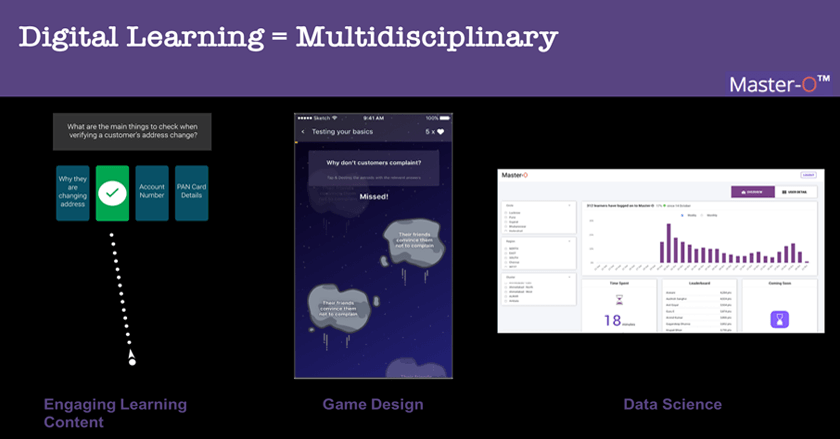Microlearning continues to be a buzzword in today's rapidly evolving digital learning landscape. It’s not just a trend but an effective approach, especially for organizations striving to improve employee retention and skill development. With its bite-sized, engaging, and highly focused nature, content created through microlearning is more likely to be retained over the long term, making it a game-changer compared to traditional learning methods.
In this blog, we will explore how Microlearning, especially mobile microlearning, gamified microlearning, and game-based microlearning, is reshaping the way frontline sales rep engage and retain information. Powered by Master-O, these innovative learning solutions are taking organizations to the next level of employee development.
What is Microlearning and How Does It Work?
Microlearning is a modern learning approach where content is:
- Bite-sized
- Focused on a single concept
- Skill-based (Microskills®)
These concise learning modules are designed for quick consumption and are integrated into microlearning platforms, which provide short-term, engaging activities. These activities can be easily woven into an employee’s daily routine, allowing them to absorb knowledge without cognitive overload. The result is, increased learning retention and more opportunities for practical application.
One of the key aspects of mobile microlearning is its ability to make learning on-the-go accessible for today’s workforce. Since mobile devices are an essential part of the modern workplace, mobile microlearning ensures that employees can engage in learning anytime, anywhere, making it even easier to integrate learning into their busy schedules.
How Does Microlearning Improve Retention?
Retention, which is the ability to store and recall information, relies on several cognitive factors such as memory capacity, attention, and the complexity of the material. Microlearning focuses on optimizing these factors, ensuring a higher chance of retaining and applying the information effectively. Let’s break it down:
1. Memory Capacity
The brain's ability to store information is vast, however short-term memory (STM) can only hold a limited amount of information at a time—approximately 7 items. By breaking down the presentation or docs into bite-sized modules, microlearning ensures that learners are absorbing smaller, more manageable pieces of information, making it easier for the STM to process and eventually store the same in long-term memory.
2. Attention
Retention also depends on the learner's ability to focus on the content. Engaging and interactive learning content, such as gamified microlearning, ensures that employees remain focused, leading to better engagement and longer retention. Gamification and microlearning go hand in hand, adding an element of fun and competition that keeps learners motivated and immersed.
With game-based microlearning, employees can compete or collaborate in learning activities that make the content not only easier to absorb but also enjoyable. This increased interaction with the content translates into more effective learning.
3. Complexity of Material
When learning materials are overly complex, it becomes more difficult for learners to remember and apply the information. Microlearning focuses on simple and singular concepts, which are easier to retain and recall. Each activity is designed around one key learning point, ensuring that employees can focus on mastering that particular skill before moving on to the next. This structured approach, combined with mobile microlearning accessibility, helps learners stay on track and prevents cognitive overload.
Why Microlearning is Ideal for Today’s Workforce
Master-O's microlearning platforms offer scalable, flexible, and effective learning solutions, especially for organizations that struggle to find time for traditional, lengthy training sessions. Whether it's via mobile or desktop, employees can engage with learning content as they work, allowing for continuous learning without disrupting productivity.
Incorporating gamified microlearning into these platforms has proven to be an effective strategy for improving engagement. The elements of gamification, such as scoring points, badges or leaderboards, can add an element of challenge and competition to the learning process, motivating employees to complete tasks and retain knowledge.
How to Leverage Microlearning for Effective Learning Retention?
- Gamified Microlearning: Use game mechanics such as points, badges, and challenges to make the learning process engaging and enjoyable.
- Mobile Microlearning: Ensure that learning materials are available on mobile devices, enabling employees to engage with content while on-the-go, ensuring learning is accessible anywhere, anytime.
- Game-Based Microlearning: Integrate learning with interactive games that allow employees to apply what they've learned in a fun and practical way.
- Focus on Practical Application: Microlearning content should always relate to real-world skills, which employees can immediately apply to their roles.
Conclusion
Microlearning, powered by mobile microlearning, gamified microlearning, and game-based microlearning, is a powerful tool for improving retention and application of knowledge in today’s digital-first world. Its ability to provide concise, engaging, and easy-to-digest learning activities makes it perfect for modern employees who need to learn quickly and efficiently.
Whether through bite-sized content, interactive games, or on-the-go access, microlearning ensures that employees remain engaged, motivated, and capable of retaining key information for the long-term.
Master-O®, a frontline sales readiness and gamification platform, has powered several sales enablement & frontline readiness programs for enterprise customers and been a key driver of sales strategies for leaders across industries. To make capability development, sales enablement & engagement more personalized, Master-O® empowers sales managers to tap into various data points and analytics for coaching & upskilling their frontline reps. This gives sales leaders and managers much-required objective perspective to reimagine their sales coaching, capability development & enablement approach and realign it with performance metrics.
At Master-O®, our mission statement is to “Elevate Customer Interactions”. We believe frontline executives in enterprises can generate more revenue and provide a differentiated customer experience if they are made more effective. To achieve that, companies rely on Master-O’s frontline readiness platform to continuously upskill, effectively enable, and engage reps to enhance revenue generation.
To learn more about Master-O®, please visit masteroapp.com or schedule a demo to discover how Master-O® can redefine sales readiness & frontline capability development for your organization.
